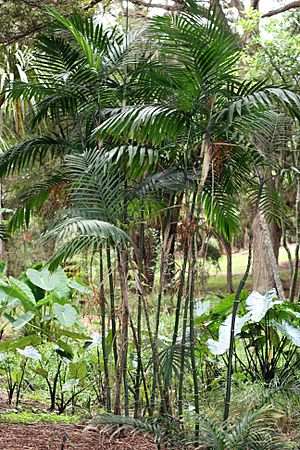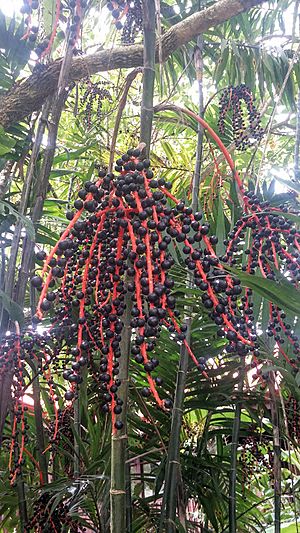Chamaedorea costaricana facts for kids
Quick facts for kids Chamaedorea costaricana |
|
|---|---|
 |
|
| Scientific classification | |
| Genus: |
Chamaedorea
|
| Species: |
costaricana
|
| Synonyms | |
|
|
Chamaedorea costaricana is a type of palm tree. It belongs to the Chamaedorea group of palms. You can find this palm growing in Central America. In Costa Rica, people often call it pacaya. But be careful, the name "pacaya" is also used for another palm called Chamaedorea tepejilote.
Contents
About the Costa Rican Palm
What Does Chamaedorea costaricana Look Like?
These palms often grow together in groups. They form either thick or spread-out bunches. Their stems grow low to the ground.
They can reach up to 6 meters (about 20 feet) tall. The stems are usually 2 to 6 centimeters (about 1-2 inches) wide.
Leaves and Flowers
Each palm usually has 4 to 6 leaves. These leaves are long, about 1 to 2 meters (3 to 6 feet) in length. They are pinnate, meaning they have many leaflets arranged like a feather. Each side of the leaf has 20 to 26 leaflets. These leaflets are slightly curved and pointed.
The flowers grow in clusters below the leaves. When they are blooming, the flower stalks stand up straight. When they have fruit, the stalks hang down. The male flowers are yellowish-green. The female flowers are pale yellow.
Fruits
The fruits of this palm are round. They are about 7 to 10 millimeters (less than half an inch) wide. When they are not ripe, they are green. As they ripen, they turn black or dark purple.
Where Does Chamaedorea costaricana Grow?
This palm is found all over Mexico and Central America. You can see it in countries like Guatemala, Honduras, Costa Rica, Nicaragua, Panama, and El Salvador.
Habitat and Environment
Chamaedorea costaricana likes to grow in wet or very wet forests. This includes cloud forests and dwarf forests. It usually grows at altitudes between 600 and 1650 meters (about 2,000 to 5,400 feet) above sea level.
It can handle full sunlight. However, it prefers shady spots in places that are hot and far from the coast.
See also
 In Spanish: Chamaedorea costaricana para niños
In Spanish: Chamaedorea costaricana para niños


